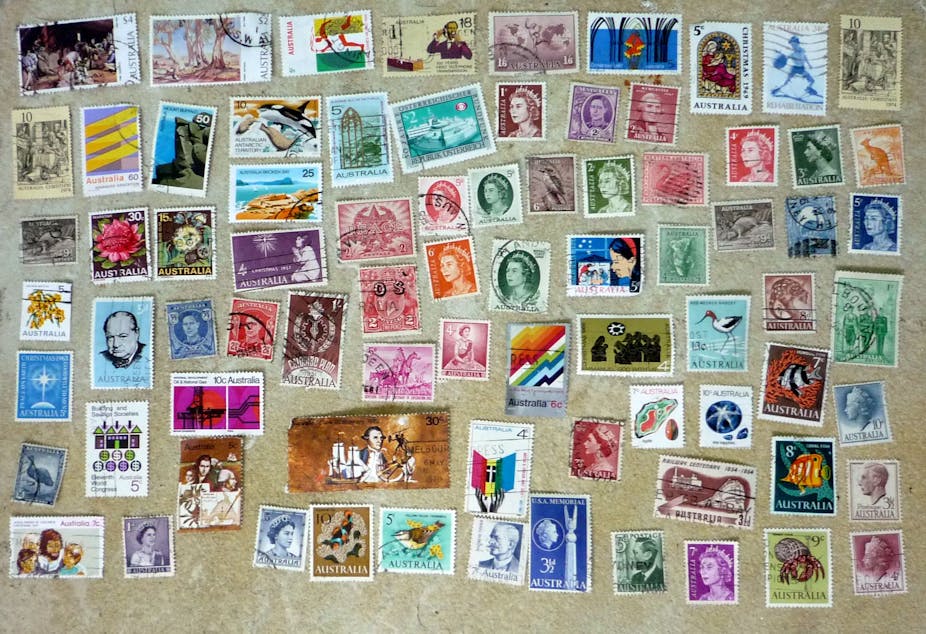Recently Australia Post announced it would seek a major price hike for mailing a letter in an attempt to save a rapidly disappearing service. Even when letters do come by post they are now largely machine-franked, rather than certified with a postage stamp.

For most of us stamps have become infrequent objects of daily life, rather like the matchbooks which used to be ubiquitous in every bar and restaurant. Posting a letter now feels a relic of the past century, replaced by an ever expanding range of electronic communication.
Stamps, however, continue to be produced in a steady stream, even if most of them go directly from the philatelic offices of government post offices to the standing orders of collectors. And every now and then they attract passing interest from the media, as in the annual announcement of Australia Day’s special issues honouring national legends.
This year’s “legends” were five Victoria Cross winners, who followed a remarkable cross section of prominent Australians since the series was initiated in 1997.

The first Australian to be so honoured was Donald Bradman, as if in tribute to newly elected Prime Minister Howard, but over the years the series has become more unpredictable, including actors, writers, chefs, fashion designers and feminists.
Other than Christmas, for which a number of special stamps are issued, the only other annual event to be commemorated is the Queen’s Birthday. No other member of the Commonwealth produces stamps each year for Her Majesty’s birthday, and finding new images rather taxes the ingenuity of our stamps designers.
Even as stamps have moved from being vital for communications to essentially producers of revenue for Australia Post, they remain official statements of national culture, which meet a set of reasonably rigorous criteria. Although there are examples, such as New Zealand and Germany, of private companies producing their own stamps for mail, postage stamps remain largely the products of government, and therefore representatives of a certain view of the world.
I admit to collecting stamps, an increasingly odd if not daggy preoccupation, but also to an interest in the symbolic uses of stamps as an insight into national political culture.

When I wrote about this in my book Paper Ambassadors (1991) I was preoccupied with the political imagery of stamps, and their consistent use for state propaganda, whether it was the Soviets extolling Sputniks and their five-year plans, the remarkable red and gold issues reflecting the Chinese Cultural Revolution, or the many US stamps which preached good citizenship and the achievements of American democracy.
More than two decades later more and more stamps are produced as commercial enterprises, less related to national celebration than to the interests of collectors, often schoolboys (collecting remains largely a preoccupation of boys of all ages).
This was already true of many ex-colonies and Communist states 40 years ago, for whom stamps represented a source of hard currency, but today the United States, for example, churns out stamps which depict cartoon characters and television programs in ways that would have shocked President Franklin Roosevelt, probably the most famous of all collectors.

Last year Finland had a marketing coup when it produced a set of stamps with clear homoerotic imagery based on the drawings of Tom of Finland, a well-known homosexual artist, and marketed them very successfully to gay men across the world, many of whom had probably not bought stamps for years. Whether any letters were sent in Finland using the stamps is less clear.
Australia Post, also, has an eye on what will sell to both collectors and enthusiasts for certain subjects, but equally there is a strong and deeply conservative image of Australia conveyed through our stamps.
An Australian who wins a Gold Medal at any of the Olympics will be honoured with a stamps, but when Richard Flanagan won the Booker Prize last year, arguably a more important win than one in, say, aerial skiing, there was no move to depict him on a stamp.

The last few years of Australian stamp issues shows a preoccupation with what one might call John Howard’s Australia, a strong emphasis on sport, on flora and fauna, on nostalgia for a simpler past and an increasing emphasis on military events.
The stamps announced for 2015 heavily feature the anniversary of the first world war, with special issues, not surprisingly, for Gallipoli.
Alongside the military there is a series depicting “tourist transport” (including Puffing Billy) and an issue about to appear honouring the 30th anniversary of the television show Neighbours.
I accept these are all part of Australian life – but how about some more imaginative and contemporary images, please? Maybe laneway graffiti or fragile environments? Not all the people who buy stamps live in John Howard’s Australia.

